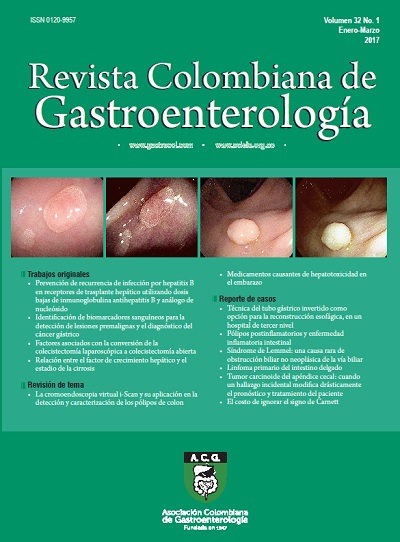Prevención de recurrencia de infección por hepatitis B en receptores de trasplante hepático utilizando dosis bajas de inmunoglobulina antihepatitis B y análogo de nucleósido
DOI:
https://doi.org/10.22516/25007440.123Palabras clave:
Trasplante de hígado, hepatitis B, inmunoglobulina, antiviralResumen
Introducción: la hepatitis B es una causa importante de trasplante hepático; produce 1 millón de muertes anuales. El uso de inmunoglobulina antihepatitis B en dosis altas y análogos de nucleósidos redujeron en un 90% la reinfección del injerto.
Objetivo: evaluar la eficacia de dosis bajas de inmunoglobulina postrasplante para prevenir la reinfección del injerto.
Metodología: serie de casos retrospectiva de pacientes trasplantados
en el Hospital “Pablo Tobón Uribe”, entre enero de 2004 y septiembre de 2014, que recibieron inmunoglobulina después del trasplante. Se evaluaron la carga viral de hepatitis B, las transaminasas y los marcadores serológicos para documentar recaída, además de variables como mortalidad, complicaciones, disfunción del injerto, reacciones adversas y costos.
Resultados: fueron 18 pacientes trasplantados con hepatitis B; 50%
tenía hepatocarcinoma; 22%, cirrosis; y 22%, insuficiencia hepática aguda. La mediana de seguimiento fue de 43,27 meses (14,7-65,2). De los pacientes, 2 tuvieron antígeno de superficie positivo en el postrasplante y en 1 hubo recaída con carga viral positiva a los 41 meses. La tasa de reinfección del injerto fue del 5,5%. No hubo muertes. Se estimó que el costo de usar dosis bajas de inmunoglobulina fue menor comparado con las dosis altas a 6 meses de terapia; sin embargo, no se hizo estudio de costo-efectividad. La disfunción del injerto fue del 10% a 33 meses.
Conclusión: con dosis bajas de inmunoglobulina se previno la reinfección del injerto, similar a lo reportado en otras series. Mientras los esquemas libres de inmunoglobulina logran demostrar su utilidad a largo plazo, usar dosis bajas de inmunoglobulina sigue siendo útil.
Descargas
Lenguajes:
esReferencias bibliográficas
European Association for the Study of the Liver. EASL clinical practice guidelines: Management of chronic hepatitis B virus infection. J Hepatol. 2012;57(1):167-85. doi: https://doi.org/10.1016/j.jhep.2012.02.010
Cubides VI, Suárez CY, Quintero PA. Epidemiología e historia natural de la hepatitis B. Rev Col Gastroenterol. 2009;24(1):4-12.
Tolosa-Pérez N. Protocolo de vigilancia en salud pública. Hepatitis B, C y coinfección hepatitis B-Delta. Bogotá: Instituto Nacional de Salud; 2014.
Lok AS. Prevention of recurrent hepatitis B post-liver transplantation. Liver Transplant. 2002;8(10 Supl 1):67-73. doi: https://doi.org/10.1053/jlts.2002.35780
Mutimer D. Review article: hepatitis B and liver transplantation. Aliment Pharmacol Ther. 2006;23(8):1031-41. doi: https://doi.org/10.1111/j.1365-2036.2006.02855.x
Marzano A, Salizzoni M, Debernardi-Venon W, et al. Prevention of hepatitis B virus recurrence after liver transplantation in cirrhotic patients treated with lamivudine and passive immunoprophylaxis. J Hepatol. 2001;34(6):903-10. doi: https://doi.org/10.1016/S0168-8278(01)00080-0
Grellier L, Mutimer D, Ahmed M, et al. Lamivudine prophylaxis against reinfection in liver transplantation for hepatitis B cirrhosis. Lancet. 1996;348(9036):1212-5. doi: https://doi.org/10.1016/S0140-6736(96)04444-3
Mutimer D, Dusheiko G, Barrett C, et al. Lamivudine without HBIg for prevention of graft reinfection by hepatitis B: long-term follow-up. Transplantation. 2000;70(5):809-15. doi: https://doi.org/10.1097/00007890-200009150-00018
Gane EJ, Angus PW, Strasser S, et al. Lamivudine plus lowdose hepatitis B immunoglobulin to prevent recurrent hepatitis B following liver transplantation. Gastroenterology. 2007;132(3):931-7. doi: https://doi.org/10.1053/j.gastro.2007.01.005
Angus PW, McCaughan GW, Gane EJ, et al. Combination low-dose hepatitis B immune globulin and lamivudine therapy provides effective prophylaxis against posttransplantation hepatitis B. Liver Transplant. 2000;6(4):429-33. doi: https://doi.org/10.1053/jlts.2000.8310
Markowitz JS, Martin P, Conrad AJ, et al. Prophylaxis against hepatitis B recurrence following liver transplantation using combination lamivudine and hepatitis B immune globulin. Hepatology. 1998;28(2):585-9. doi: https://doi.org/10.1002/hep.510280241
Xi ZF, Xia Q. Recent advances in prevention of hepatitis B recurrence after liver transplantation. World J Gastroenterol. 2015;21(3):829-35. doi: https://doi.org/10.3748/wjg.v21.i3.829
Ahn J, Cohen SM. Prevention of hepatitis B recurrence in liver transplant patients using oral antiviral therapy without long-term hepatitis B immunoglobulin. Hepat Mon. 2011;11(8):638-45. doi:https://doi.org/10.5812/kowsar.1735143X.717
McCaughan GW, Spencer J, Koorey D, et al. Lamivudine therapy in patients undergoing liver transplantation for hepatitis B virus precore mutant-associated infection: high resistance rates in treatment of recurrence but universal prevention if used as prophylaxis with very low dose hepatitis B immune globulin. Liver Transplant.1999;5(6):512-9. doi: https://doi.org/10.1002/lt.500050601
Togashi J, Akamastu N, Sugawara Y, et al. One-year extended, monthly vaccination prophylaxis combined with hepatitis B immune globulin for hepatitis B after liver transplantation. Hepatol Res. 2016;46(3):E51-9. doi: https://doi.org/10.1111/hepr.12526
Varghese J, Sachan D, Reddy MS, et al. Hepatitis B immunoglobulin prophylaxis after liver transplantation: experience in a tertiary transplant centre. J Clin Exp Hepatol. 2014;4(3):209-13. doi: https://doi.org/10.1016/j.jceh.2014.07.007
Lim YS, Han S, Heo NY, et al. Mortality, liver transplantation, and hepatocellular carcinoma among patients with chronic hepatitis B treated with entecavir vs lamivudine. Gastroenterology. 2014;147(1):152-61. doi:https://doi.org/10.1053/j.gastro.2014.02.033
Teperman LW, Poordad F, Bzowej N, et al. Randomized trial of emtricitabine/tenofovir disoproxil fumarate after hepatitis B immunoglobulin withdrawal after liver transplantation. Liver Transplant. 2013;19(6):594-601. doi: https://doi.org/10.1002/lt.23628
Choudhary NS, Saraf N, Saigal S, et al. Low-dose short-term hepatitis B immunoglobulin with high genetic barrier antivirals: the ideal post-transplant hepatitis B virus prophylaxis? Transpl Infect Dis. 2015;17(3):329-33. doi: https://doi.org/10.1111/tid.12369
Tanaka T, Renner EL, Selzner N, et al. One year of hepatitis B immunoglobulin plus tenofovir therapy is safe and effective in preventing recurrent hepatitis B post-liver transplantation. Can J Gastroenterol Hepatol. 2014;28(1):41-4. doi: https://doi.org/10.1155/2014/839014
Fung J, Cheung C, Chan SC, et al. Entecavir monotherapy is effective in suppressing hepatitis B virus after liver transplantation. Gastroenterology. 2011;141(4):1212-9. doi: https://doi.org/10.1053/j.gastro.2011.06.083
Jeong SW, Choi Y, Kim JW. Management of viral hepatitis in liver transplant recipients. Clin Mol Hepatol. 2014;20(4):338-44. doi: https://doi.org/10.3350/cmh.2014.20.4.338
Descargas
Publicado
Cómo citar
Número
Sección
Licencia
Aquellos autores/as que tengan publicaciones con esta revista, aceptan los términos siguientes:
Los autores/as ceden sus derechos de autor y garantizarán a la revista el derecho de primera publicación de su obra, el cuál estará simultáneamente sujeto a la Licencia de reconocimiento de Creative Commons que permite a terceros compartir la obra siempre que se indique su autor y su primera publicación en esta revista.
Los contenidos están protegidos bajo una licencia de Creative Commons Reconocimiento-NoComercial-SinObraDerivada 4.0 Internacional.


| Estadísticas de artículo | |
|---|---|
| Vistas de resúmenes | |
| Vistas de PDF | |
| Descargas de PDF | |
| Vistas de HTML | |
| Otras vistas | |















